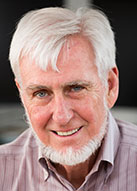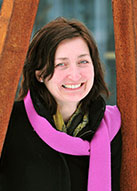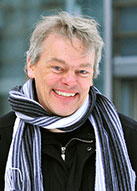Scientists at UCL and NTNU awarded Nobel Prize for discovering brain's positioning system
6 October 2014
The 2014 Nobel Prize in Physiology or Medicine has been awarded to Professor John O’Keefe of University College London (half the prize) and husband-and-wife team Professors May-Britt Moser and Edvard Moser (one quarter prize each) of the Norwegian University of Science and Technology (NTNU) for the discovery of cells that constitute a positioning system in the brain.
Professor O’Keefe, now Director of the Sainsbury Wellcome Centre for Neural Circuits & Behaviour at UCL and Head of UCL Cell & Developmental Biology, discovered the first component of this positioning system in 1971 when he found a type of nerve cell in the hippocampus that was activated when a rat was in one location in a room, with a different set of cells active when the rat was in a different location. He concluded that these ‘place cells’ formed a map of the room.
In 2005, May-Britt and Edvard Moser discovered another key component of the brain’s positioning system. They identified another type of nerve cell, which they called “grid cells”, that generate a coordinate system and allow for precise positioning and pathfinding. Their subsequent research showed how place and grid cells make it possible to determine position and to navigate. They are the first Norwegians to be awarded the Nobel prize in medicine.
 Prof John O'Keefe |
 Prof May-Britt Moser |
 Prof Edvard Moser |
The importance of the discoveries is summed up by the Nobel Assembly at Karolinska Institutet: The discoveries of John O´Keefe, May-Britt Moser and Edvard Moser have solved a problem that has occupied philosophers and scientists for centuries — how does the brain create a map of the space surrounding us and how can we navigate our way through a complex environment? The sense of place and the ability to navigate are fundamental to our existence. The sense of place gives a perception of position in the environment. During navigation, it is interlinked with a sense of distance that is based on motion and knowledge of previous positions.
John O'Keefe
Professor O’Keefe discovered that certain nerve cells were activated when the animal assumed a particular place in the environment. He could demonstrate that these “place cells” were not merely registering visual input, but were building up an inner map of the environment. O’Keefe concluded that the hippocampus generates numerous maps, represented by the collective activity of place cells that are activated in different environments. Therefore, the memory of an environment can be stored as a specific combination of place cell activities in the hippocampus.
John O’Keefe was born in 1939 in New York City, USA, and holds both American and British citizenships. He received his doctoral degree in physiological psychology from McGill University, Canada in 1967. After that, he moved to England for postdoctoral training at University College London. He has remained at University College and was appointed Professor of Cognitive Neuroscience in 1987. As mentioned above, he is the Director of the new Sainsbury Wellcome Centre for Neural Circuits & Behaviour at UCL and also Head of UCL Cell & Developmental Biology.
May-Britt and Edvard Moser
May-Britt and Edvard Moser were mapping the connections to the hippocampus in rats moving in a room when they discovered an astonishing pattern of activity in a nearby part of the brain called the entorhinal cortex. Here, certain cells were activated when the rat passed multiple locations arranged in a hexagonal grid. Each of these cells was activated in a unique spatial pattern and collectively these “grid cells” constitute a coordinate system that allows for spatial navigation. Together with other cells of the entorhinal cortex that recognize the direction of the head and the border of the room, they form circuits with the place cells in the hippocampus. This circuitry constitutes a comprehensive positioning system, an inner GPS, in the brain.
May-Britt Moser was born in Fosnavåg, Norway in 1963. She studied psychology at the University of Oslo together with her future husband and co-Laureate Edvard Moser. She received her Ph.D. in neurophysiology in 1995. She was a postdoctoral fellow at the University of Edinburgh and subsequently a visiting scientist at University College London before moving to the Norwegian University of Science and Technology in Trondheim in 1996. May-Britt Moser was appointed Professor of Neuroscience in 2000 and is currently Director of the Centre for Neural Computation in Trondheim.
Edvard I. Moser was born in born 1962 in Ålesund, Norway. He obtained his Ph.D. in neurophysiology from the University of Oslo in 1995. He was a postdoctoral fellow together with his wife and co-Laureate May-Britt Moser, first at the University of Edinburgh and later a visiting scientist in John O´Keefe´s laboratory in London. In 1996 they moved to the Norwegian University of Science and Technology in Trondheim, where Edvard Moser became Professor in 1998. He is currently Director of the Kavli Institute for Systems Neuroscience in Trondheim.
Comment from NTNU:
"This is the first time the Nobel Prize in medicine has been awarded to Norway. It is not surprising that it has been awarded to the Moser husband-and-wife team," says Gunnar Bovim, NTNU Rector.
"Their work in neuroscience focusing on memory and sense of place is internationally groundbreaking, and they have already won most of the international awards that it is possible to achieve in their field," said Bovim. "The award of the world's foremost scientific honour at this relatively early stage of their career is a strong statement about the level of their research. This is very inspiring for all of us," he said.
Alzheimer's affect on awareness of positioning
Recent investigations with brain imaging techniques, as well as studies of patients undergoing neurosurgery, have provided evidence that place and grid cells exist also in humans. In patients with Alzheimer´s disease, the hippocampus and entorhinal cortex are frequently affected at an early stage, and these individuals often lose their way and cannot recognize the environment. Knowledge about the brain´s positioning system may, therefore, help us understand the mechanism underpinning the devastating spatial memory loss that affects people with this disease.
The discovery of the brain’s positioning system represents a paradigm shift in our understanding of how ensembles of specialized cells work together to execute higher cognitive functions. It has opened new avenues for understanding other cognitive processes, such as memory, thinking and planning.